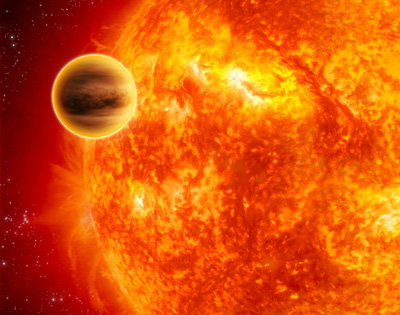An international group of astrophysicists has determined that a massive planet outside our Solar System is being distorted and destroyed by its host star--a finding that helps explain the unexpectedly large size of the planet, WASP-12b.
It's a discovery that not only explains what is happening to WASP-12b, it also means scientists have a one-of-a-kind opportunity to observe how a planet enters this final stage of its life.
"This is the first time that astronomers are witnessing the ongoing disruption and death march of a planet," said Douglas N.C. Lin, professor of astronomy and astrophysics at UC Santa Cruz. Lin is a coauthor of the new study and the founding director of the Kavli Institute for Astronomy and Astrophysics (KIAA) at Peking University, which was deeply involved with the research. The findings are being published in the February 25 issue of Nature.
The research was led by Shu-lin Li of the National Astronomical Observatories of China. A graduate of KIAA, Li and a team of researchers analyzed observational data on the planet to show how the gravity of its parent star is both inflating its size and spurring its rapid dissolution.
WASP-12b, discovered in 2008, is one of the most enigmatic of the 400-plus planets that have been found outside our Solar System over the past 15 years. It orbits a star in the constellation Auriga that is roughly similar in mass to our Sun. Like most known extrasolar planets, it is large and gaseous, resembling Jupiter and Saturn in this respect. But unlike Jupiter, Saturn, or most other extrasolar planets, it orbits its parent star at extremely close range--75 times closer than the Earth is to the Sun, or just over 1 million miles. It is also larger than astrophysical models would predict. Its mass is estimated to be almost 50 percent larger than Jupiter's and its volume is six times Jupiter's. It is also unusually hot, with a daytime temperature of more than 2500 degrees Celsius.
Some mechanism must be responsible for expanding this planet to such an unexpected size, say the researchers. They have focused their analysis on tidal forces, which they say are strong enough to produce the effects observed on WASP-12b.
On Earth, tidal forces between the Earth and the Moon cause local sea levels rise and fall modestly twice a day. WASP-12b, however, is so close to its host star that the gravitational forces are enormous. The tremendous tidal forces acting on the planet completely change its shape into something similar to that of a rugby or American football.
These tides not only distort the shape of WASP-12b. By continuously deforming the planet, they also create friction in its interior. The friction produces heat, which causes the planet to expand. "This is the first time that there is direct evidence that internal heating (or 'tidal heating') is responsible for puffing up the planet to its current size," said Lin.
Huge as it is, WASP-12b faces an early demise, Lin said. In fact, its size is part of its problem. It has ballooned to such a point that it cannot retain its mass against the pull of its parent star's gravity. As the study's lead author Li explained, "WASP-12b is losing its mass to the host star at a tremendous rate of six billion metric tons each second. At this rate, the planet will be completely destroyed by its host star in about ten million years. This may sound like a long time, but for astronomers it's nothing. This planet will live less than 500 times less than the current age of the Earth."
The material that is stripped off WASP-12b does not directly fall onto the parent star. Instead, it forms a disk around the star and slowly spirals inwards. A careful analysis of the orbital motion of WASP-12b suggests circumstantial evidence of the gravitational force of a second, lower-mass planet in the disk. This planet is most likely a massive version of the Earth--a so-called "super-Earth."
The disk of planetary material and the embedded super-Earth are detectable with currently available telescope facilities. Their properties can be used to further constrain the history and fate of the mysterious planet WASP-12b.
In addition to KIAA, support for the WASP-12b research came from NASA, Jet Propulsion Laboratory, and the National Science Foundation. Along with Li and Lin, co-authors include Jonathan Fortney, assistant professor of astronomy and astrophysics at UCSC, and UCSC graduate student Neil Miller.



